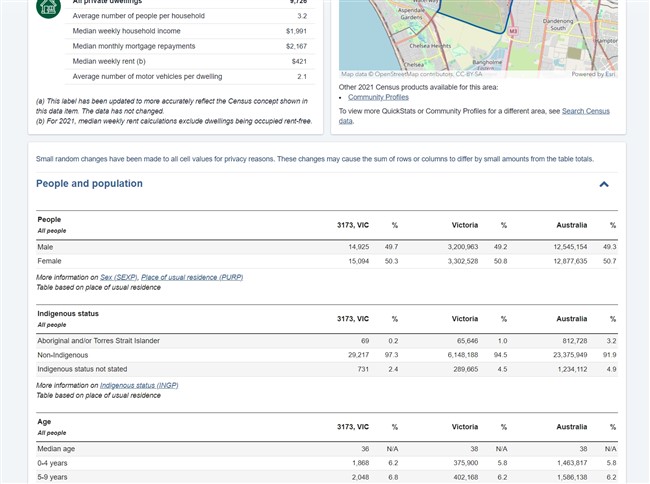Understanding your local customer base is crucial for success as a retailer with a physical shop. A powerful tool widely used is local market research, which involves a demographic analysis of your shop's feeder area. Let's explore how you can leverage these demographics to boost your business.
Why Demographic Analysis Matters
By understanding who lives in your feeder area, you can:
- Profile your product range better to meet local needs
- Adjust your pricing strategy based on local income levels
- Create better marketing campaigns that resonate with your community
- Plan store hours that align with local work patterns
- Improve customer service by understanding cultural nuances
How to Conduct a Demographic Analysis
Step 1: Census data for retailers

- Visit the Australian Bureau of Statistics website here:
- Select the most recent census year (currently 2021) - red arrow
- Enter your shop's postcode in the location field - blue arrow
- Review the wealth of information at your fingertips; it will go on for pages. Do not let it overwhelm you!

Step 2: Demographic analysis for retail
As a rule, I recommend you focus on these crucial demographic factors:
- Age distribution
- Income levels
- Family structures
- Cultural diversity
- Employment rates
- Education levels
- Housing types
Step 3: Compare to State Averages
Understanding how your area differs from broader trends can highlight unique opportunities or challenges.
Putting Data into Action: A Real-World Example
Let's look at postcode 3173 here as an example:
MetricPostcode 3173VictoriaAustralia
Median Age363838
Median Weekly Household Income$1,991$1,759$1,746
Couples with Children55.4%LowerLower
Unemployment Rate5.4%5.0%5.1%
Key Insights:
-
Younger Population: With a median age of 36, this area skews younger than state and national averages. Consider stocking products that appeal to a younger demographic or families with young children.
-
Higher Income: The median weekly household income is significantly higher than average. This could support a premium product range or luxury items.
-
Family-Oriented: Family-friendly products and services could be a hit with many couples with children.
-
Cultural Diversity: The area boasts significant Chinese, Vietnamese, Cambodian, and Indian communities. Consider stocking culturally relevant products, e.g. Chinese New Year cards.
-
Slight Employment Challenges: The slightly higher unemployment rate might impact discretionary spending.
Think of products example:
Kids games
Based on the demographic data for postcode 3173, I would say that kids' games could be a good business opportunity. Here's why, along with some considerations:
Positives:
1. Young population: The area has a higher proportion of children compared to state and national averages:
2. Family-oriented community: 55.4% of families are couples with children, higher than state and national averages.
3. Higher household income: The median weekly household income ($1,991) is higher than Victorian averages, suggesting families might have more disposable income for children's products.
4. Educational focus: Asian cultures often emphasize education. Educational games or those that develop skills might be a hit.
5. Traditional and outdoor board games could be good for family time.
By leveraging demographic analysis, you're not just running a shop—creating a tailored experience that resonates with your local community. This level of understanding and adaptation can set your brick-and-mortar business apart in today's competitive retail landscape.
Get it a shot. It will only take you a few minutes.


